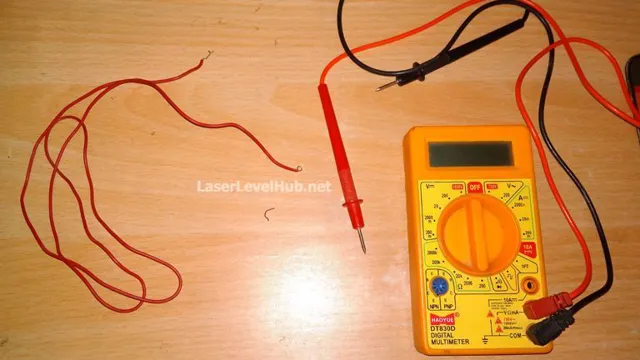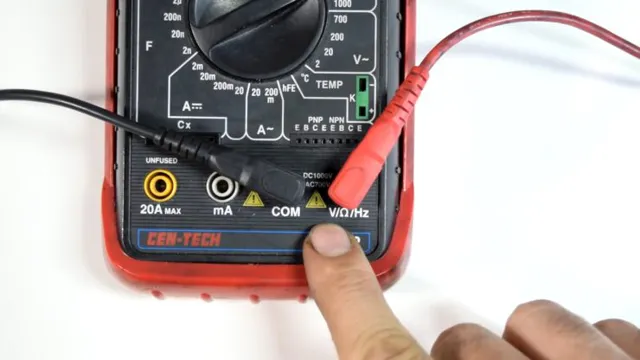Testing wires with a voltage tester can be a daunting task, especially for those who are not electricians. Electrical systems can be complicated, and there are many factors to consider when testing wires. However, testing wires is crucial when it comes to safety and ensuring that an electrical system is functioning correctly.
A voltage tester is an essential tool that helps to identify the presence of electrical current in a wire. It can be used to test the voltage level, ensure that a circuit is not live, and detect any potential safety hazards. In this blog, we will discuss the basics of testing wires with a voltage tester and provide you with some tips to make the process less intimidating.
What is a voltage tester?
If you’re working on electrical projects, it’s important to know how to test wires with a voltage tester. Essentially, a voltage tester is a tool that allows you to determine if there is electrical current present in a wire. This is important because it can help you avoid electrocution or other electrical hazards.
Using a voltage tester is relatively simple – you simply touch the tip of the tester to the wire you wish to test. If there is electrical current present, the tester will emit a signal such as a light or an audible tone. If you’re unsure how to use a voltage tester, it’s always a good idea to consult an expert or professional before attempting any electrical work.
Overall, a voltage tester can be an essential tool for anyone who works with electricity, and learning how to use one properly can help you stay safe and effective on the job.
Definition and types of voltage testers
A voltage tester is a device used to determine the presence or absence of electrical voltage in a particular circuit or wiring system. It is an essential tool that all electricians and DIY enthusiasts must-have. There are various types of voltage testers, and each has its specific functions and applications.
Non-contact voltage testers use electromagnetic fields to determine the presence of voltage without touching the circuit. Continuity testers, on the other hand, check if there is a complete path of electricity between two points in a circuit. Solenoid-based voltage testers use a magnetic field to detect voltage, while digital multimeters measure voltage and other electrical signals accurately.
It is vital to choose the right voltage tester for the job and ensure that it is safely used to avoid accidents. Always test the tester itself to make sure it is functioning correctly before using it. With that said, a voltage tester comes in various types and shapes, but all serve the same purpose of measuring electrical voltage.

How to use a voltage tester to test wires?
If you’re planning on doing any kind of electrical work, it’s essential to know how to use a voltage tester to test wires safely and accurately. To start, make sure the power source to the circuit is turned off before attempting to test any wires. Once the power is off, select the appropriate voltage range on your tester and hold the probe near the wire you want to test.
Then, touch the probe to the wire itself or the insulation surrounding it and note the reading on the tester. If the voltage reading is within the expected range, then the wire is likely functioning properly. However, if the reading is higher or lower than expected, there may be an issue with the wire or connected components.
Always follow proper safety procedures when testing wires, and if you’re unsure about anything, consult an expert electrician for further guidance. By using a voltage tester regularly, you can ensure your electrical system is working safely and efficiently.
Step-by-step guide on testing wires
Testing wires can be a bit daunting, but with the right tools and techniques, anyone can do it. One of the best tools to use is a voltage tester, which helps determine if wires are live or not. To use a voltage tester, start by turning off the power source to the wires you want to test.
Then, insert the tester’s probes into the wire in question and observe the reading on the tester. A reading of zero means the wire is not live, while a reading above that indicates a live wire. Make sure to test the wire at different points to ensure accuracy and safety.
By using a voltage tester, you can confidently and safely test wires, ensuring that your electrical projects are accurate and secure.
Identifying live and neutral wires
Testing wires to identify live and neutral wires is crucial to ensure electrical safety in your home. Using a voltage tester is the most reliable method to check if a wire is live or neutral. Firstly, turn off the circuit breaker for the area where the wires will be tested.
Next, take the voltage tester and switch it to AC voltage mode. Place the end of the tester on the exposed wire, making sure the wire is not touching anything else, and turn the circuit breaker back on. If the voltage tester beeps and lights up, then the wire is live, meaning it carries electrical current.
If the voltage tester remains silent and doesn’t light up, then the wire is neutral, which means it doesn’t have electric current coursing through it. Remember to always test and confirm which wire is live and neutral before handling any electrical wiring to avoid accidents.
Avoiding common mistakes while testing wires
When testing wires, it’s important to avoid common mistakes that could potentially harm you or damage the electrical system you’re working on. One key tool to use is a voltage tester, which can help you determine whether a wire is active or not. To use a voltage tester, first, turn off the power source to the wires you plan to test.
Then, touch one end of the tester to the wire while holding the other end with your free hand. If the tester doesn’t light up, the wire is not active. However, if the tester lights up, that means the wire is live and carrying electrical current.
In this case, it’s important to avoid touching the wire or any surrounding metal objects, as this could potentially lead to electric shock or injury. Remember to always handle wires with caution, and if you’re unsure of what you’re doing, it’s best to seek help from a professional electrician.
Safety precautions while testing wires
When testing wires with a voltage tester, it’s important to take safety precautions to avoid electrocution or other hazards. First and foremost, ensure that the power source is turned off before even starting the testing process. Once the power is off, double-check that there is no voltage in the wire by testing it with the voltage tester before touching any part of the wire with your hands.
If the tester indicates a voltage, do not touch the wire. Additionally, use insulated gloves and tools to avoid the risk of accidental contact with an energized wire. Always follow the manufacturer’s instructions for your specific voltage tester to ensure proper use and understanding of the tool.
By taking these safety measures, you can reduce the risk of electrocution or other injuries while testing wires with a voltage tester.
Protective clothing and equipment
Protective clothing and equipment When it comes to testing wires, safety precautions should be taken seriously. Protective clothing and equipment are essential to keep you safe from any electrical hazards. This includes wearing rubber gloves, safety glasses, and protective clothing like a lab coat.
You should also wear insulated shoes and boots to keep your feet protected from electrical shocks. It is important to remember that even small voltages can cause serious harm, so make sure to use a voltage detector before handling any wires. Additionally, make sure to keep your workspace tidy and organized to prevent tripping hazards.
Finally, always turn off the power before working on any wiring. Remember, taking safety precautions can save lives, so don’t take any risks when it comes to electrical work.
Preventing electrical shock
Electrical shock is a serious risk when working with wires, but there are safety precautions you can take to prevent injuries. First, make sure the power is turned off before testing wires. Use a voltage tester to confirm that no electricity is flowing through the wires.
Next, wear protective gear such as rubber gloves and safety glasses to prevent any accidental contact with live wires. It is also important to inspect the wiring for any signs of damage or frayed insulation before testing. Finally, do not work on electrical wiring alone.
Make sure someone else is nearby in case of an emergency. By following these precautions, you can safely test wires without the risk of electrical shock.
Conclusion
Testing wires with a voltage tester may seem intimidating, but it’s as easy as slicing through a stick of butter with a hot knife. Just make sure to turn off the power supply, attach the tester to a ground wire, and touch the probe to the wire you want to test. If the tester lights up like a Christmas tree, then you’ve got voltage flowing through your wires.
And if not, well, it’s time to call an electrician or swap out some fuses. Either way, with a voltage tester in hand, you’ll be able to electrify your home with confidence and ease.”
FAQs
What is a voltage tester?
A voltage tester is a tool used to detect the presence of electrical current in wires or outlets.
How do you use a voltage tester?
To use a voltage tester, insert the tester’s probes into an outlet or touch them to a wire. If the tester lights up or makes a sound, that indicates the presence of electrical current.
Can a voltage tester be used on live wires?
Yes, voltage testers are designed to be used on live wires. However, it is important to be cautious and follow safety precautions to avoid electrocution.
How can you test wires without a voltage tester?
One way to test wires without a voltage tester is to use a multimeter, which can measure voltage, resistance, and other electrical properties.
What is the difference between an analog and a digital voltage tester?
Analog voltage testers use a needle to indicate the presence of electrical current, while digital voltage testers display a numeric reading on a screen.
Can a voltage tester be used to test batteries?
Yes, some voltage testers can be used to test batteries by measuring their voltage output.
What are some common safety precautions when using a voltage tester?
Common safety precautions when using a voltage tester include wearing gloves and eye protection, avoiding touching live wires with your bare hands, and turning off power to the circuit you are testing.






